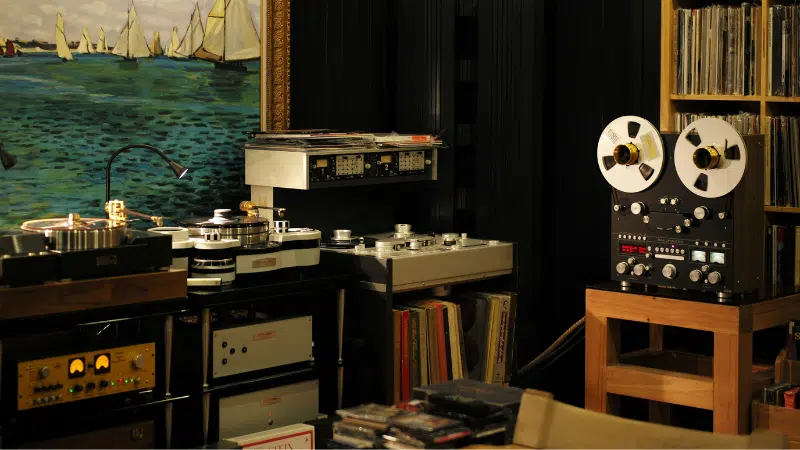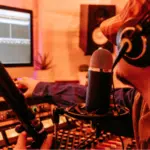In an industry taken over by stream and algorithm chasing, giving your audience something they can physically hold onto can set you apart from the crowd in a big way. Physical products create moments of connection. Moments that stick with them for the long haul. The memory of what songs you played at your show may fade, but the fan who bought your merch can pull that vinyl off their shelf in 20 years and reminisce with their kids about where they got it, what it meant to them, and even pass it on for future generations to cherish. Whether it’s a signed record bought at your show or a limited merch drop that fans can share on socials, physical distribution isn’t just about moving products. It’s about turning casual listeners into lifelong supporters. In this article, we’re breaking down some of our favorite tips and tricks to help you connect with your fans through the power of physical distribution.
How To Leverage Physical Distro Sales To Grow Your Fanbase
Printing physical music isn’t just for legacy acts and audiophiles. For indie artists, it can actually be a smart move if you’re ready for it. Doing so can feel like a big step, and that’s because it is! Between the upfront costs, production timelines, and figuring out how to actually sell it, there’s a lot to consider. But when done right, physical formats can deepen your connection with fans, offer something truly collectible, and open up new revenue streams.
All that said, how do you know when you’re actually ready to take the leap? // Check out “How to Know When You’re Ready to Print Physical Music” to get the full rundown.
The Power of Physical Distribution
Yeah, streaming is convenient, but it’s also passive. People can stumble across your track on a playlist but move on without ever learning your name. Physical music, on the other hand, makes things more personal. It creates a moment you can hold onto. Something fans can remember, collect, and come back to later.
When someone buys your vinyl or CD, they’re not just supporting you financially; it’s an act of commitment. They’re saying, “I believe in this enough to physically own it.” And that kind of emotional investment builds a stronger, longer-lasting connection. Physical formats also add a sense of value that digital just can’t match. Holding your music in their hands makes it feel more real. And that experience, unwrapping a record, reading the liner notes, displaying it on a shelf, all of this creates a relationship with your art that algorithms could never replicate.
——
🧠 Feed yo’ brain…
Top Music Analytics Tools for Independent Artists
How To Use User-Generated Content To Market Your Music
How To Feed The Spotify Algorithm To Get More Streams
How To Market Your New Release On A $0 Budget
——
But how can you turn these purchases into fan engagement?
Selling something physical is great and all, but turning that moment into a deeper connection is where the real magic happens. To do this, start by personalizing the experience. A signed CD, a handwritten note, or unique packaging gives fans something personal they’ll remember. It’s these small details that turn a typically regular purchase into an experience.
Next, you have to get them to talk about it. Encourage fans to share their unboxing or collection on social media by including a quick note like “Tag me when this arrives, bc I love seeing where these end up!” or whatever fits your vibe. This not only adds a little charisma from you personally, but it gives them a reason to post and creates natural word-of-mouth buzz that introduces you to new listeners.
And when those fans post, they’re not just showing off their merch, they’re promoting your music in a way that’s authentic and personal. Plus, you can take it a step further by sending a thank-you DM, email, or even a voice memo to show your appreciation and open the door for more engagement down the line. With this, you can also start collecting emails and/or contact info, and follow up with sneak peeks, exclusive drops, or early access to your next releases.
This extra effort shows you care, and fans remember that.
Make The Most of Your Merch Table
When fans come to your show, they’re already emotionally invested. They’ve gotten ready, made the effort to show up, and that puts them in the perfect headspace to become long-term supporters (if they aren’t already). Physical products at shows tap into that energy and turn it into something lasting.
After all, the merch table isn’t just about sales, it’s part of the experience. It’s where someone can take the night home with them. A record they buy right after the encore doesn’t just sit on a shelf; it becomes a time capsule of the night they saw you live.
This is also one of the few moments you get to connect in real life. A quick signature, a conversation, or even just eye contact and a thank you. People don’t forget the artists who made them feel seen. That’s why it’s also important to be intentional with how you set it up. Make it easy to browse. Bundle products together. Offer something exclusive to that night or city. These little decisions can turn casual listeners into fans who bring their friends to the next show… or even follow you to the next city.
⚡️ PRO TIP:⚡️To really make an impact, your setup should not only be easy to navigate but visually appealing, too. Use good lighting, clear signage with pricing, and make sure everything is organized. (I promise you nobody wants to dig through a pile of shirts or guess how much a record costs.)
Connect with Local Record Stores
Record stores are more than just retail spaces! They serve as cultural hubs for the community. For indie artists, getting your music on the shelves of your local shop can be a powerful way to meet new fans and show you’re serious about your craft. The even cooler part? You don’t need a label or a distributor to make it happen. Most local shops just love supporting independent artists, especially when there’s a hometown connection. Just walk in, introduce yourself, and ask if they’re open to consignment or direct sales. Bring a few well-packaged copies, a one-sheet, and a good attitude.
Once you’re in, don’t stop there. See if they’d be down to host a listening party, a small acoustic set, or a signing. Events like these give people a reason to pull up, connect with your music in real life, and maybe even walk out with a record in hand. Plus, when your vinyl or CD is sitting next to major artists, it sends a subtle yet powerful message that yes, you belong here too.
Record stores can be a shortcut to building local buzz, especially if you show up, get involved, and treat it like more than just a transaction. It’s about being a part of your community and connecting with others in the scene who care about this industry just as much as you do.
Physical Sales 🤝 Lifelong Fans
Selling something physical isn’t just about making a few extra bucks. Think of it like an invitation into your world, and if you play it right, it’s the start of something bigger. When you treat each physical release as a moment, whether it’s a limited edition drop, a signed vinyl at a show, or a bundle only available to your email list, you’re creating more than a product. You’re building an experience, and experiences are what fans remember for years to come.
This is where collecting emails when people buy from you, adding personalized notes to your packaging, or including a QR code linking to a private video or unreleased demo really makes all the difference. These simple touches make people feel seen, and that’s what turns someone from a casual buyer into a true supporter. You don’t need to go over the top, just be intentional. Show your fans that every sale is more than a transaction for you. It’s the beginning (or continuation) of a relationship.
To wrap things up…
All too often, artists typically put their CDs, merch, etc., into the world and forget about it until it’s time to count the sales. But putting out physical products that represent you as an artist goes so much deeper than just making some money. It offers a line of appreciation from you directly to the fans who support you the most, spending their hard-earned money to show their love for what you’ve created.
That connection is what turns casual listeners into real supporters. When someone holds your vinyl or wears your shirt, they’re not just buying a product; they’re investing in your story and becoming part of your journey. And that’s the kind of relationship that fuels an artist’s career throughout and ups, downs, and everything in-between.
When done with care, physical distribution becomes one of your strongest tools for building a community that sticks around no matter what.
Good luck!



